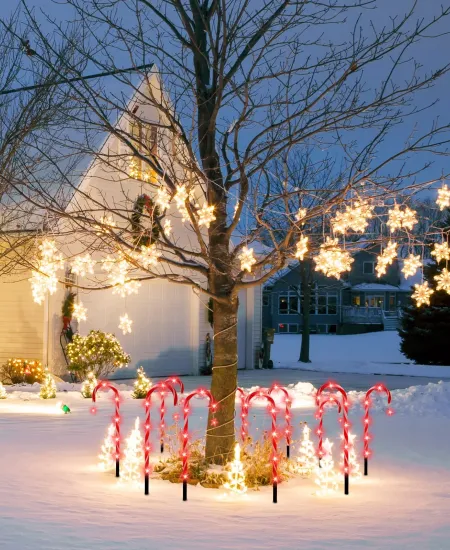The Lowdown on Weatherproof Christmas Lights
Every year, as the festive season approaches, it seems like the entire neighborhood lights up almost overnight with vibrant Christmas decorations. My journey into making my own home a winter wonderland often began with a trip up to the attic, hauling down boxes of tangled lights, hoping they’d light up. And oh, don’t get me started on the year I decided to put up lights during an unexpected snow flurry. Thankfully, I’ve learned a few things about weatherproof Christmas lights since then, which has saved me not only from potential disasters but from freezing in the middle of the yard, testing bulb after bulb.
Built to Brave the Elements: Understanding Weatherproofing in Holiday Lights
Weatherproofing is essential when it comes to outdoor Christmas lights. Learnings from many a chilly experiment have shown me that not all ‘outdoor lights’ are created equal. Some can handle a light frost while others can withstand everything Mother Nature throws at them without a flicker. Here's what keeps them shining despite the weather.
- Water Resistance: This is non-negotiable. Weatherproof lights are usually marked with an IP rating, which tells you how resistant they are to solids (like dust) and liquids. An IP44 rating or higher is good for outdoor lights because it means they're protected against objects larger than 1mm and water splashes from all directions.
- Molded Bulbs: Unlike the indoor varieties with bulbs that screw in and out, many outdoor sets have bulbs that are permanently affixed. This molding seals the bulb to the socket, keeping moisture out—a crucial factor, as I learned after a half-lit display two years back.
- Thick and Flexible Plastic Casing: Heavier plastic covers the wires, protecting them from freezing and cracking. Flexible casing is vital for withstanding the bending and winding around trees or porch columns without breaking.
As much as we focus on durability against water and cold, wind resistance is another critical aspect of outdoor Christmas lights. Ensuring that your lights are securely fastened allows them to withstand even the most blustery of December nights.
The Nitty-Gritty: Materials Matter in Weatherproof Lighting
Diving deeper into what makes or breaks the longevity of outdoor holiday lights, I learned that material choice is paramount. Here’s the scoop on what keeps those lights resilient:
- LEDs vs. Incandescent: LED lights are not only more energy-efficient but they also generate less heat and are sturdier compared to their incandescent cousins. Their solid-state construction means they're less likely to break down in fluctuating temperatures. More on testing LEDs outdoors if you're curious.
- Rubberized Cables: Rubber cables are generally better than plastic ones for outdoor use, because rubber remains flexible even in cold weather—no more wrestling with stiff wires!
- Gold-plated Contacts: Cheaper lights often use aluminum contacts which can corrode when exposed to humidity and saline conditions. Gold-plated contacts, although more expensive, resist corrosion much more effectively, extending the life of your light set.
Storage also plays a massive role in maintaining the quality of your lights off-season. I used to just chuck mine in a box and toss them in the garage, but once I started storing lights properly, their lifespan magically extended. (advancedplatingtech.com)
Personal Tales from the Tangled Lines of Christmas Past
Thinking back, my first attempt at outdoor Christmas decor was a comedy of errors. There stood I, with a staple gun and a string of the cheapest, thinnest lights one could find. Flash forward to the morning after our first winter storm—my front yard looked like a lightbulb massacre. Staples had rusted, and lights were half hanging off the edge of our gutters. It was a disaster, albeit a hilarious one in hindsight.
Over the years, I’ve upped my game. I’ve upgraded to sturdier, more reliable weatherproof lighting and invested in proper tools and storage. My current go-to Christmas light set features epoxy-encapsulated bulbs, UV-resistant coatings, and snug-fitting connectors. Sure, it might cost a bit more, but the difference in durability is astronomical. Plus, the last thing anyone wants is troubleshooting lighting problems when it’s freezing outside.
A Merry and Bright Conclusion
Making sure your Christmas lights are suited to withstand the elements isn’t just about technical specs—it’s about creating that magical holiday sparkle without extra stress. Seal those connections, choose your materials wisely, and always store your lights thoughtfully. Maybe most importantly, remember that a little investment in quality now can lead to many bright, merry Christmases in the future.
If you’re venturing out to pick your set, keep these tips in mind and maybe your holiday lights will become a season highlight, not a weather-worn headache. Cheers to fewer bulb replacements and more hot chocolate breaks! For full outdoor setups, you can also learn how to light up the exterior properly.
So go ahead, deck those halls with lines of weatherproof lights that promise a little more twinkle for your buck and a lot more ease for your peace of mind.
Subscribe to our email newsletter and unlock access to members-only content and exclusive updates.

Comments